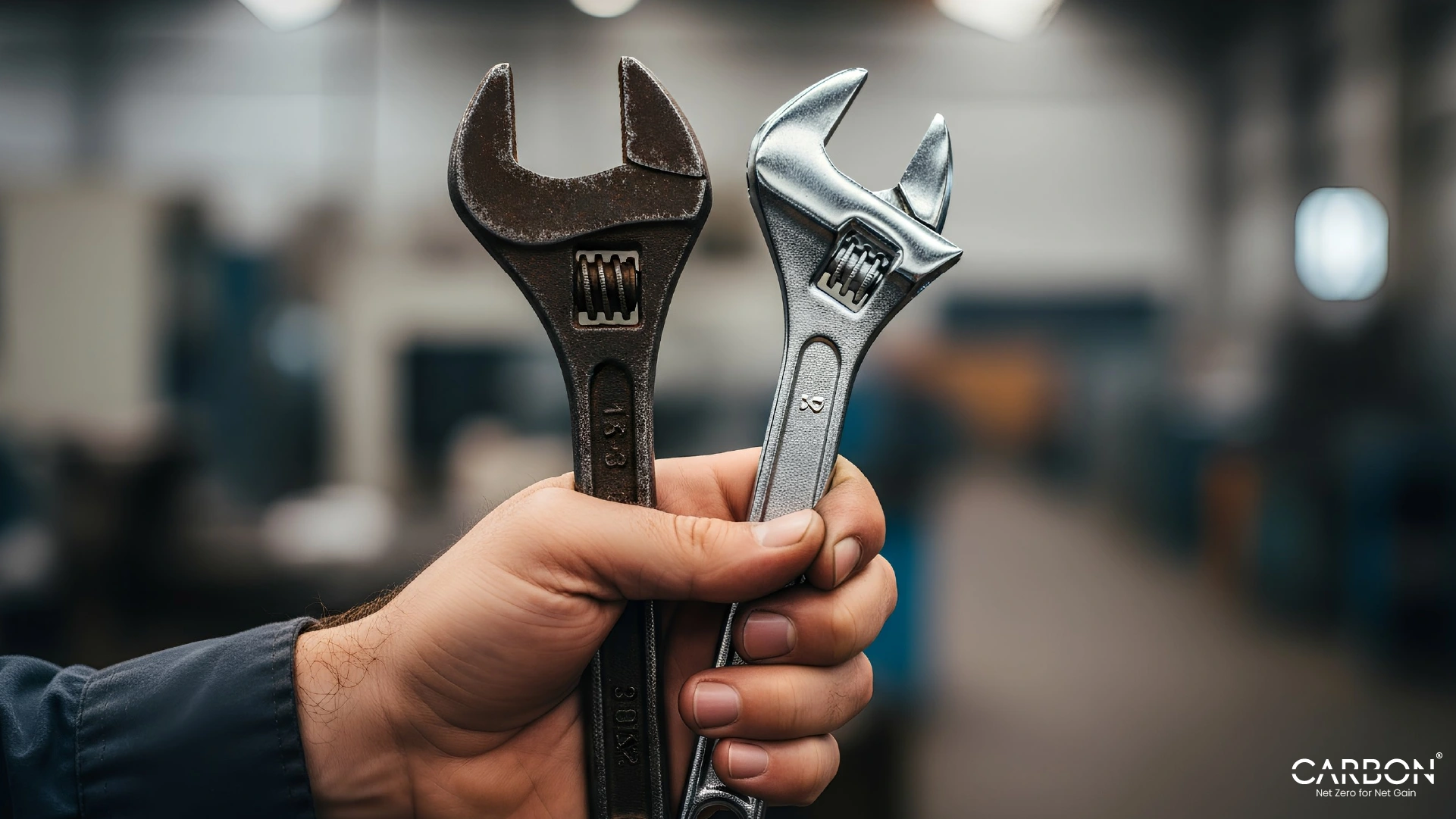Key Takeaways
- Sustainability now drives margin, growth, and resilience.
- Consumers and investors are rewarding ESG performance.
- ESG is moving from siloed teams to core operations.
- Circular design and smart tech unlock new value streams.
- The most adaptable businesses embed ESG into strategy.
Sustainability used to be something companies did after they handled the real work. A separate report. A small team. A regulatory checkbox.
Not anymore.
In 2025, the leaders are the ones meeting ESG requirements and also using those same requirements to rethink how they grow, how they operate, and how they compete.
Sustainability has become a lever, one that smart companies are pulling to drive innovation, strengthen resilience, and build lasting value.
Yes, it comes with cost. But that cost isn’t a penalty, rather a down payment on agility, efficiency, and long-term survival. The sooner businesses treat ESG as a business driver, not an obligation, the faster they’ll move.
This blog shows how companies are making that shift. And how you can turn ESG from a reporting burden into a growth engine.
Why Sustainability Now Drives Enterprise Value
If sustainability still sounds like a cost, you’re looking at it through the wrong lens.
In 2025, the smartest companies are no longer asking “Do we have to do this?” They’re asking “How fast can we turn this into an advantage?”
Why? Because the connection between ESG and business value isn’t abstract anymore. It’s hard-coded into how companies operate, compete, and grow.
Efficiency = Profit
Let’s start at the ground level. Less energy. Less waste. Smarter materials. These are more than feel-good moves, but actual margin drivers.
Companies that embed sustainability into operations through smarter procurement, better energy use, and waste reduction, are seeing real returns. McKinsey reports 15–25% operational savings in key areas within 2–3 years.
That’s not theoretical. That’s margin expansion, pure and simple.
Customers Choose Principles
The numbers are in.
Nearly 70% of consumers say they prefer brands with clear sustainability commitments. Over 60% are willing to pay more for them (Capgemini, 2024).
And in B2B? ESG is showing up in procurement scorecards and contract requirements. Companies without visible, verifiable commitments are already losing bids.
Reputation = Access
Trust travels fast and so does risk.
Investors now control over $50 trillion in ESG-screened assets. Over 85% of institutional investors systematically factor ESG into their decisions.
Add to that:
- Public ESG disclosures are now mandatory under CSRD and ISSB
- Younger talent—60%+ of the workforce by 2025—prioritize sustainable employers
- Reputational equity can create a 5–10% valuation premium for high-ESG firms
Innovation from Constraint
Limits spark invention. Sustainability pressures, including carbon caps, material scarcity, circularity goals are forcing companies to rethink how they design, build, and deliver.
The result? New revenue streams. New materials. New business models.
- Circular economy players are seeing 20–30% gains in resource productivity
- Markets for recycled-content goods are growing double digits year over year
When constraints are real, innovation becomes the way forward.
Resilience Is Strategic
Sustainability also builds the one thing businesses can’t fake: adaptability.
Companies with embedded ESG have weathered recent energy spikes and supply disruptions better than their peers. In 2023–2024, firms with higher ESG scores outperformed the market by up to 5% during volatility (S&P Global).
The cost of climate-related business disruption is already over $200 billion per year, and rising.
Bottom line: ESG is a structural advantage as it boosts efficiency, deepens loyalty, defends margins, and opens doors. And keeps companies steady in a market that’s anything but.
How to Operationalize Sustainability as a Strategic Lever
Knowing that sustainability drives value is one thing. Embedding it into your business model? That’s where most companies stall.
It’s not for lack of intent. It’s lack of structure.
Turning ESG from aspiration to execution means changing how decisions get made, who owns the work, and where the data lives. Here’s how companies are doing it in practice and where they’re seeing results.
a. Hardwire ESG into Decision-Making
Sustainability can’t live in a silo. If it’s not part of procurement, R&D, HR, and capital planning, it won’t stick.
Action Needed: Redesign procurement scorecards to include emissions performance, circularity potential, and social standards, not just cost. Many leaders now weigh sustainability at 15–20% in supplier selection criteria.
b. Set Aggressive, Auditable Targets
Targets that aren’t measured get ignored. Targets that can’t be audited don’t get funded.
Action Needed: Align your internal KPIs with external frameworks like CSRD, ESRS, or SBTi. As of early 2025, over 5,000 companies have set or committed to Science Based Targets. Companies using integrated platforms can automate ESG tracking, streamline assurance, and create audit trails, reducing both cost and risk.
c. Activate the Ecosystem
You can’t hit net-zero if your suppliers don’t move with you. Scope 3 lives upstream and downstream. So should your engagement.
Action Needed: Launch supplier engagement programs tied to Scope 3 visibility and ethical sourcing. Companies actively engaging their suppliers on climate report 20% more effective reductions in supply chain emissions (CDP, 2024).
d. Invest in Enablers, Not Just Intentions
Slide decks don’t cut emissions. Tech does.
Digital twins. AI-powered analytics. Predictive maintenance. These aren’t just IT upgrades, but how sustainability becomes repeatable, measurable, and real.
Action Needed: Use ESG platforms that integrate with operations, enabling real-time decisions. The ESG tech market is growing at 20% CAGR, expected to top $5B by the end of 2025 (Verdantix). That’s where the infrastructure is going.
e. Design for Circularity
Linear models are dying. “Take-make-waste” is being replaced with “recover-reuse-regenerate.”
Action Needed: Audit your product and process lifecycle. Identify where waste can become raw input. Accenture estimates the circular economy will unlock $4.5 trillion in value globally by 2030. That’s not a fringe model, it’s a strategic reset.
Real-World Wins: Companies Turning ESG into Advantage
The shift from ESG intent to ESG impact is already happening.
Across industries, the companies making bold moves are seeing real returns. Faster growth. Stronger brand equity. Better margins. And in many cases, preferential access to capital and talent.
These are operating strategies with measurable upside.
Patagonia: Loyalty Through Circularity and Purpose
Some companies bolt sustainability onto the side of their brand. Patagonia didn’t.
It built its entire model around environmental purpose from using recycled fabrics to running a full product repair program. The Worn Wear initiative keeps products in use and customers coming back. The brand’s stance on activism, transparency, and supply chain ethics has earned it loyalty and long-term growth without sacrificing credibility.
Unilever: Sustainable Brands, Scaled Growth
Unilever’s “Sustainable Living Brands” have consistently outperformed. At one point, they were growing 69% faster than the rest of the portfolio. Why? Because customers increasingly back brands that walk the talk and Unilever turned that into a market advantage.
IKEA: Scale + Sustainability Can Coexist
IKEA didn’t wait for regulations to shift, so it started redesigning its business for the future years ago.
They’re working toward a fully circular product line by 2030. That means materials are recycled, reused, or renewable. Their stores offer take-back programs. Their energy mix includes a growing share of renewables.
And their sourcing policies have evolved to protect forests at scale. None of this is about checking a box. It’s about controlling risk in a global supply chain and building trust with customers who are watching closely.
Common Barriers to Sustainability and How to Clear Them
It’s easy to look at companies like Patagonia, IKEA, or Unilever and think—they’ve got the scale, the budget, the time. But most organizations aren’t starting from scratch. They’re stuck somewhere in the middle.
Progress is blocked not by intention, but by friction.
Here are the barriers that come up again and again, and how leading companies are moving through them.
Barrier 1: The Cost Looks Too High
The upfront investment can feel steep, especially in tech, energy systems, or supply chain changes. But that view misses the real question: What’s the cost of doing nothing?
A 2024 CDP report found companies actively investing in emissions reduction projects reported an average ROI of over 20%. That’s not a sunk cost. It’s margin recovery and risk prevention.
Barrier 2: Ownership Is Trapped in a Silo
When sustainability is owned by a small team, it gets treated like a side project. Strategy dies in silos.
The companies making real progress have ESG embedded into operations, finance, IT, and procurement. It’s cross-functional because that’s where the levers are.
Solution: Rebuild ESG governance to include the decision-makers who control capital, data, and supply chains, not just the sustainability lead.
Barrier 3: The Data’s a Mess
ESG reporting demands traceability, consistency, and assurance-ready inputs. That’s hard to deliver when data is buried in spreadsheets, scattered across vendors, or tied to legacy systems.
Over 60% of companies in 2024 surveys reported struggling with ESG data quality and availability.
Solution: Standardize sources. Automate collection. Assign ownership. If it can’t be audited, it can’t be trusted, and it definitely can’t drive value.
Barrier 4: The Rulebook Keeps Shifting
Between CSRD, ESRS, ISSB, and local mandates, it’s easy to feel like the target is moving.
But complexity doesn’t have to equal confusion. The direction of travel is clear: more transparency, more integration, more accountability.
Solution: Build flexibility into your systems. Don’t wait for “final” guidance, start with what’s known, and stay adaptable. Compliance isn’t a one-off. It’s a capability.
The Most Resilient Businesses Are the Most Sustainable
If the last few years taught us anything, it’s this: adaptability wins.
Companies that already had ESG systems in place—real systems, not slide decks—navigated energy price shocks, supply chain volatility, and investor scrutiny with less disruption and more confidence.
They were ready.
S&P Global found that high-ESG performers outpaced their peers by up to 5% during periods of market volatility in 2023–2024. At the same time, climate-related disruptions are projected to cost businesses over $200 billion annually by 2025 if adaptation doesn’t scale.
So the question isn’t should you invest in sustainability. It’s how quickly you can embed it into how your business runs.
Companies that treat ESG as a constraint will always be chasing compliance. Companies that treat it as a strategy will drive performance, unlock capital, and build trust that lasts.
The leaders in 2025 aren’t just meeting the standard. They’re setting it.
FAQs
Isn’t sustainability still just about compliance?
That’s where it starts. But in 2025, companies that stop there are missing the bigger picture. ESG is showing up in contract bids, investor filters, even hiring decisions. Compliance is the entry fee. Growth comes from going further.
Does ESG actually drive profit or just reputation?
It does both. Energy efficiency, smarter materials, and waste reduction cut costs. ESG-linked finance lowers capital costs. And brands with strong sustainability signals are outperforming in customer loyalty and pricing power.
What’s the business case for circularity?
Circular design is good ethics and good economics. When companies reduce waste, reuse materials, or recover products at end-of-life, they gain control over supply chains and unlock new revenue streams. This isn’t theory. Global circular models are projected to unlock trillions in value.
How does sustainability make a business more resilient?
Think about energy prices in the last two years. Or material shortages. Or regulatory shifts. Companies with diversified supply chains and clear ESG data moved faster and took fewer hits. ESG isn’t just for peace of mind. It’s for stability under pressure.
What’s the first move if we’re stuck in the early stages?
Don’t try to boil the ocean. Start by identifying where ESG is already happening, then formalize it. Create measurable targets. Assign ownership. Focus on data you can trust. You don’t need to be perfect. You just need to move with purpose.




